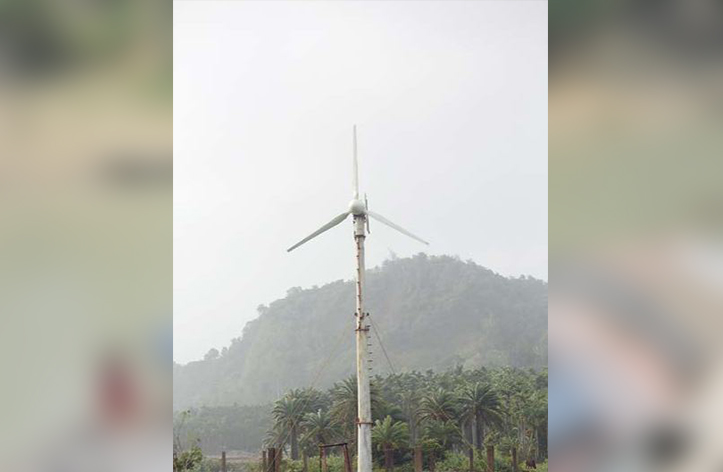Bangladesh is a densely populated developing country of 160 million people in a land area of 56,977 sq miles. As much as 60-70% of households in rural and coastal Bangladesh have no access to electricity.
Renewable energy expansion in grid-energy deprived regions of developing countries can be critical to promote sustainable livelihood and development. In terms of natural and technical terms, there is significant potential in Bangladesh to generate energy from solar (50,174MW), wind (4,614MW), hydropower (550MW), and grid-connected biomass (566MW) sources.
Within a larger investigation on global energy access to poor population, a study has been undertaken in four villages or clusters in the district of Khulna, in the southern coastal belt of Bangladesh, to assess living conditions before and after renewable energy systems had been installed.
As part of the study, three out of these four villages were provided with either wind, solar, or a hybrid (solar plus wind) energy technology systems; and a fourth, control cluster was not provided with any renewable or other modern energy technology.
In order to capture socio-economic, livelihoods, climate change, and environment information pre- and post-energy access, a questionnaire was applied, a year apart, to five households in each village, making a total of 20 participants. Periodic data was also captured on local atmospheric indicators and power output from the three installed energy systems.
Some of the findings were enlightening in proving the extent to which energy access may promote some positive life-changing conditions among poor communities.
For example, 49.3%, 24.6%, 15.5%, and 15.1% increase in household income was registered for the solar, hybrid, wind, and control clusters respectively. If the control cluster were the expected change in income levels, ie 15.1% after one year, the contribution of renewable energy to household income levels above the level of the control cluster are 34.2%, 9.5%, and 0.4% for solar, hybrid, and wind cluster respectively.
Assessing the livelihood sources before and after incorporation of clean, off-grid energy technologies to three communities showed that several people who were travelling out of their localities for employment purposes were now remaining in their own locality and expanding their agricultural activities by using the energy in innovative ways, eg as a source of heat for the chicks in the poultry farms during the winter months.
A recent visit to the hybrid cluster was particularly instructive. An educated female member of a family took advantage of the light sources in the evening to tutoring kids from within and outside her village. Light was also being used for handicraft-making purposes for the women of the same household.
Two striking findings were that people’s willingness to pay for energy had risen by three folds, and energy demand increased amongst the groups which had access to modern energy.
Once they had access to energy, users realised how useful and beneficial it can be in their lives and hence they expressed an increased need for energy, and also an increased willingness to pay.
In terms of power output from solar, wind, and a solar-wind hybrid systems, the most stable power output was derived from solar during daylight hours.
The hybrid technological solution generated 24 hour power output and coverage as the daylight hours were supported by the solar power; and from the evenings, generally the wind speed picks up and the wind turbine output provides coverage for the evening and night time.
Yet, the stand-alone wind system faced intermittency in power output and the sporadic nature of the power was not very useful for the communities.
The study found that there is good potential for the hybrid systems, which not only provide daytime and night time coverage, but it is also able to provide a larger output through which the communities can expand beyond just four LED light bulbs and a mobile phone charger, which is generally the most common components in a Solar Home System.
The clustering model worked quite well and by sharing the costs the communities will be able to diversify their renewable energy portfolio and attain increased output.
The future could potentially see such clusters being set up with a range of different renewable energy technologies followed by connecting micro-grid devices for more efficient storage and utilisation. Clusters of micro-grids may subsequently be joined to a mini-grid. In turn, excess energy generated from mini-grid clusters could be fed into the national grid.
Bangladesh has pledged to move towards 100% renewable energy by 2050. It may sound like a distant date, and the energy that is generated in the three villages in Khulna may only seem like a small contribution towards increasing the share of renewable power in the total country energy production.
Nonetheless, such ambitious national target requires that a transition to cleaner sources of energy starts now, and takes place in any sector wherever it is possible.
Thinking of future expansion of such energy systems requires that sustainable financing is available and possible market-based scenarios are considered.
It is likely that poor communities could approach micro-credits or loans to access the technologies; yet, the increase in income that this study has shown possible would go towards supporting the repayment of instalments.
In addition, enabling policy, regulatory, and financial support are critical in bringing about this change, which will take the pressure off the government to provide electricity from the national grid to rural and coastal remote locations.
In this way, the currently limited power output may be utilised in manufacturing-based sectors, which will create employment and contribute to GDP growth.
Adapting to renewables

